|
|
|
Sort Order |
|
|
|
Items / Page
|
|
|
|
|
|
|
| Srl | Item |
| 1 |
ID:
162088


|
|
|
|
|
| Summary/Abstract |
This article is based on data from a study undertaken in 2014-2015 in rural southern Shaanxi to analyse the relationship between bachelors who have not chosen to be single and their satisfaction with life. Its aims are twofold: firstly, to explain the differences in the quality of life between married and single men by means of conventional variables (socio-economic profile, state of health, intensity of social relations); secondly, to explore quality of life factors associated with relations these men have with women and which, to our knowledge, have never hitherto been taken into account in analyses of inequalities in life satisfaction in China. In particular, we attempt to see the extent to which inability to contract a marriage is likely to affect quality of life, especially through the social injunction to marry and the social stigmatisation attached to bachelorhood, while at the same time exploring how quality of life varies in relation to the frequency of intimate relations with partners in a context where sex remains socially associated with marriage. In this way, we bring to light individual and contextual features that can be considered to contribute to the growth of inequality in life satisfaction resulting from socio-economic circumstances.
|
|
|
|
|
|
|
|
|
|
|
|
|
|
|
|
| 2 |
ID:
115672
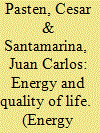

|
|
|
|
|
| Publication |
2012.
|
| Summary/Abstract |
Energy is required to sustain life. A human-centered analysis of the worldwide energy situation is conducted in terms of quality of life-related variables that are affected, but not directly determined, by energy consumption. Data since 1980 show a continuous global increase in both energy consumption and quality of life, and lower population growth in countries with higher quality of life. Based on these trends, we advance non-linear energy consumption predictions and identify various plausible scenarios to optimally steer future energy demands, in order to maximize quality of life. The scenarios consider the coupling between energy consumption rate per capita, quality of life, population growth, social inequality, and governments' energy-for-life efficiency. The results show the energy cost of increasing quality of life in the developing world, energy savings that can be realized by limiting overconsumption without impacting quality of life, and the role of governments on increasing energy-for-life efficiency and reducing social inequality.
|
|
|
|
|
|
|
|
|
|
|
|
|
|
|
|
| 3 |
ID:
126821


|
|
|
|
|
| Publication |
2014.
|
| Summary/Abstract |
The near- and long-term societal effects of declining EROI are uncertain, but probably adverse. A major obstacle to examining social implications of declining EROI is that we do not have adequate empirical understanding of how EROI is linked, directly or indirectly, to an average citizen's ability to achieve well-being. To evaluate the possible linkages between societal well-being and net energy availability, we compare these preliminary estimates of energy availability: (1) EROI at a societal level, (2) energy use per capita, (3) multiple regression analyses and (4) a new composite energy index (Lambert Energy Index), to select indicators of quality of life (HDI, percent children under weight, health expenditures, Gender Inequality Index, literacy rate and access to improved water). Our results suggest that energy indices are highly correlated with a higher standard of living. We also find a saturation point at which increases in per capita energy availability (greater than 150 GJ) or EROI (above 20:1) are not associated with further improvement to society.
|
|
|
|
|
|
|
|
|
|
|
|
|
|
|
|
| 4 |
ID:
173878
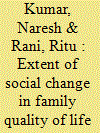

|
|
|
|
|
| Summary/Abstract |
The present study finds family quality of life index (FQLI) for 14 states of India. The study used 55 family health indicators collected from National Family Health Survey (NFHS) for the period 2005–2006 and 2015–2016. The Wroclaw taxonomic technique is used to find the FQLI. Small improvement has been observed in FQLI (2015–2016) in comparison with FQLI (2005–2006). Out of the 14 states, Goa is ranked first and Bihar is ranked last in the FQLI for the period 2005–2006 and 2015–2016. The study confirmed the existence of interstate disparities in FQLI.
|
|
|
|
|
|
|
|
|
|
|
|
|
|
|
|
| 5 |
ID:
103907
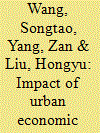

|
|
|
|
|
| Publication |
2011.
|
| Summary/Abstract |
Over the past decade, China's major cities have experienced significant real estate price increase which has been fueled by the sustained growth of the economic fundamentals. It is well believed that deeper integration with the world market is one of the major reasons for such high speed macroeconomic growth. In this paper, we examined the linkage between urban economic openness, the ratio of trade volume as a percentage of GDP, and urban real estate prices basing on the quality of life theory as well as Balassa-Samuelson (B-S) effects. Using panel data of 35 large Chinese cities from the year 1998 to 2006, we empirically find that for every 1% increase in urban economic openness, urban real estate prices will increase significantly by 0.282%, after controlling for other traditional demand-supply factors. Urban economic openness alone accounted for about 15.90% appreciations of Chinese real estate prices during the sample period, which is not neglectable. This result implies that urban real estate price fluctuations are potentially affected by international economic factors. The economic distance to the international market could be deemed as productive and consumption amenity for a city as well. This study enriches the perception of quality of life factors, and furthermore provides a new perspective for understanding the real estate price dynamics in the globalized economic development today.
|
|
|
|
|
|
|
|
|
|
|
|
|
|
|
|
| 6 |
ID:
140013
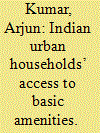

|
|
|
|
|
| Summary/Abstract |
The need for access to basic amenities—drinking water, sanitation, electricity and drainage—to ensure a decent quality of life has been internationally and nationally recognised and acted upon in the form of Millennium Development Goals (MDGs) and various policies and programmes in India. Deprivation and disparities in access to basic amenities in urban India have been highlighted in this article, using data from Census 2001 and 2011 and National Sample Survey’s (NSS) Housing Conditions Rounds unit records data 1993 and 2008–09. Determinants of households having access to basic amenities in the house have been estimated using an econometric exercise on household-level information (NSS, 2008–09). Despite improvement over time, many households in urban India still face deprivations of basic amenities and, hence, low standard of living. Households located in slums and small and medium towns/cities and those belonging to Poor, Scheduled Tribe, Scheduled Caste and Wage Labourers (Casual Labourers) groups were highly deprived of access to basic amenities, and disparities among various socioeconomic groups were observed to be increasing. Findings suggest the need for urgent attention for providing basic amenities, focused on slums, small and medium towns/cities and supplemented with inclusive, group-specific measures in order to raise the overall quality of life and well-being.
|
|
|
|
|
|
|
|
|
|
|
|
|
|
|
|
| 7 |
ID:
138253


|
|
|
|
|
| Summary/Abstract |
The 1895 Pamir Convention divided the mountainous region of Badakhshan into separate entities under Russian and British/Afghan influence, leading to a remarkable divergence in the development fortunes of a people once united by kinship. For those in today’s GornoBadakhshan in Tajikistan, incorporation into the Soviet Union brought investments in education, health, physical infrastructure, and the economy. People living in Afghanistan’s Badakhshan Province retained more political freedom but lived remotely within a feudal state where development investment was limited. In recent decades, both regions have experienced conflict that has affected their development. In this article, we use findings from quality of life assessments carried out by the Aga Khan Development Network to illustrate the stark differences between the Badakhshans. We discuss ongoing efforts to implement cross-border development programmes to improve quality of life in both Badakhshans, while noting that their success depends on a stable security environment in the region.
|
|
|
|
|
|
|
|
|
|
|
|
|
|
|
|
| 8 |
ID:
081195


|
|
|
|
|
| Publication |
2008.
|
| Summary/Abstract |
This study responds to the recognition that the majority of military spouses have paid employment but that neither the Department of Defense nor other organizations understand their motivations for work or their perceptions of how the military lifestyle has affected their employment. This article summarizes the input from more than a thousand military spouses who participated in interviews for this research. Qualitative and quantitative methods were used to examine spouse experiences and perceptions regarding their employment. Findings indicate that the majority of military spouses believe that the military has a negative effect on their employment. In addition, the interviews revealed that these spouses work for a variety of reasons, both financial and nonpecuniary. The reasons for the military's negative effect and spouse motives for working are discussed, along with the ensuing implications for policy
|
|
|
|
|
|
|
|
|
|
|
|
|
|
|
|
| 9 |
ID:
159837
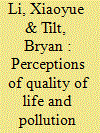

|
|
|
|
|
| Summary/Abstract |
After decades of rapid economic development, China is facing severe environmental problems. In particular, smog in urban areas has recently attracted a great deal of scientific and media attention both domestically and internationally. Our focus in this article is on public perceptions of smog in the northern city of Tangshan, which is routinely ranked as one of the urban areas with the worst air quality in the nation. In this article, we present the results of qualitative interviews and quantitative surveys with 341 urban residents. We examine how these residents perceive and weigh the importance of various aspects related to quality of life, including their experience with air pollution. Study participants considered environmental quality an issue of lower priority than many others; however, they surprisingly ranked it over economic concerns such as jobs and income. Their responses suggest that, for many urban residents, environmental problems like smog are fundamentally linked to basic quality of life concerns such as physical health and family well-being. We interpret our findings in the context of literature on the rise of China's middle class, the rise of environmental consciousness, and the role of gender in mediating perceptions of pollution and family health. We also consider the implications of these findings for the control and remediation of air pollution in China today.
|
|
|
|
|
|
|
|
|
|
|
|
|
|
|
|
| 10 |
ID:
166500
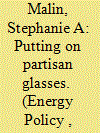

|
|
|
|
|
| Summary/Abstract |
Unconventional oil and gas technologies—such as hydraulic fracturing—have drastically increased the volume of oil and gas produced in the U.S., while simultaneously bringing drilling closer to residential areas. We examine quality of life impacts of unconventional oil and gas production, arguing that how people perceive its local effects is rooted in their political identities. Using survey data from three northern Colorado communities, we employ counterfactual mediation methods to understand relationships between political identity, perceived socio-environmental and community changes from oil and gas development, and self-reported quality of life. We find significant differences in how people perceive local development based upon political identity, whereby Tea Party supporters see little negative impact, and in turn are likely to believe that local development improves their quality of life. At the other extreme, Democrats perceive more negative community changes from oil and gas development and are more apt to believe that it reduces their quality of life.
|
|
|
|
|
|
|
|
|
|
|
|
|
|
|
|
| 11 |
ID:
182802
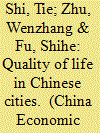

|
|
|
|
|
| Summary/Abstract |
The Rosen-Roback spatial equilibrium theory states that cross-city variations in wages and housing prices reflect urban residents' willingness to pay for urban amenities or quality of life. This paper is the first to quantify and rank the quality of life in Chinese cities based on the Rosen-Roback model. Using the 2005 1% Population Intercensus Survey data, we estimate the wage and housing hedonic models. The coefficients of urban amenity variables in both hedonic models are considered the implicit prices of amenities and are used as the weights to compute the quality of life for each prefecture-level city in China. In general, provincial capital cities and cities with nice weather, good air quality, and accessible public transit have high quality of life. We also find that urban quality of life is positively associated with the subjective well-being of urban residents.
|
|
|
|
|
|
|
|
|
|
|
|
|
|
|
|
| 12 |
ID:
174807
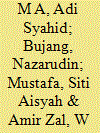

|
|
|
|
|
| Summary/Abstract |
This article investigates the quality of life of the Kelantan Chinese Muslim community before and after conversion to Islam, focusing on their level of satisfaction in term of economic aspect. This research was carried out using the sequential explanatory mixed method design involving 75 respondents selected for quantitative and five respondents for qualitative. The sampling method adopted was convenience and snowball samplings. The research data was collected using questionnaires and semi-structured interviews. The results revealed that respondents were moderately satisfied before conversion and satisfied after conversion. Besides that, there is no significant difference of quality of life before and after conversion to Islam (F = 0.868, p = 0.355) and it was not influenced by the period of conversion to Islam (F = 0.832, p = 0.589). This analysis indicates numerous respondents are still moderately satisfied in their quality of life even though the average data shows they are satisfied after conversion.
|
|
|
|
|
|
|
|
|
|
|
|
|
|
|
|
| 13 |
ID:
147069
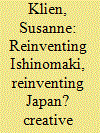

|
|
|
|
|
| Summary/Abstract |
This article aims to give an outline of recent developments in Ishinomaki, one of the cities worst affected by the Great East Japan Earthquake in March 2011. Before the disaster, the harbor town faced depopulation, aging residents, and a lack of prospects for the young, like many other stagnant regional cities. Since March 2011, Ishinomaki has seen an influx of short-, mid-, and long-term volunteers and young ambitious individuals who have moved from urban areas to initiate their own revitalization or social business projects. Drawing on and showing the limitations of Richard Florida’s notion of the ‘Creative Class’, this paper approaches Ishinomaki’s recent reinvention and transition from production to postindustrial multi-functionality as a phenomenon that can be seen as both a renaissance movement as well as the result of the structural instability of the labor market caused by Japan’s transition into a mature postindustrial economy.
|
|
|
|
|
|
|
|
|
|
|
|
|
|
|
|
| 14 |
ID:
119895
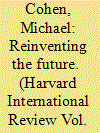

|
|
|
|
|
| Publication |
2012.
|
| Summary/Abstract |
The urbanization of developing countries is transforming global climate, landscapes, societies, and cultures. The strong pull of cities and towns for higher wages and quality of life has emptied rural areas and provided higher incomes, education, health status, longevity, and, for many, liberation from the limitations of rural life.
|
|
|
|
|
|
|
|
|
|
|
|
|
|
|
|
| 15 |
ID:
170171
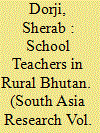

|
|
|
|
|
| Summary/Abstract |
In Bhutan, recent increases in annual teacher attrition rates, particularly in rural areas, pose significant challenges for the government and concerned agencies in terms of retaining qualified teachers and reducing teacher attrition rates and turnover. This article, partly based on a field study exploring the quality of work life (QWL) and well-being of school teachers in rural Bhutan, explores the possible reasons why such teachers might seek to resign. Using mixed methodology, the study reveals poor QWL and well-being of teachers, caused by a variety of factors. In view of such findings, the Ministry of Education and the government need to ensure better all-round protection for teachers to avoid the risk of large-scale resignations.
|
|
|
|
|
|
|
|
|
|
|
|
|
|
|
|
| 16 |
ID:
189420
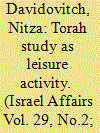

|
|
|
|
|
| Summary/Abstract |
This article discusses the contribution of Torah study as leisure activity to social support, hope and quality of life among Israeli adults. It shows that such study is associated positively with learners’ quality of life due to the acquisition of psychological resources that include social support by peers and hope. Shedding light on the world of people who study Torah as a leisure activity, the article also reveals that cultural sources that are part of an ancient tradition seem to contribute to one’s quality of life in the modern world as well.
|
|
|
|
|
|
|
|
|
|
|
|
|
|
|
|
|
|
|
|
|